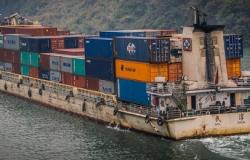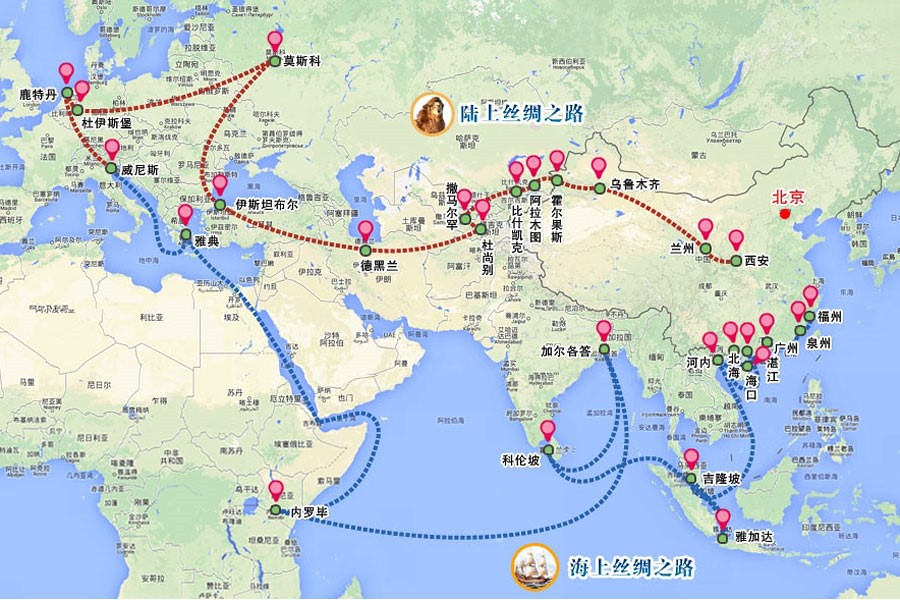The Maritime Silk Road Initiative (MSRI): Why India is Worried, What China Can Do

Amitendu Palit argues that the China-led Maritime Silk Road Initiative is causing ripples among Indian policymakers.
Regional connectivity and infrastructure capacities in Asia are poised to change remarkably following the implementation of the China-led Belt-and-Road Initiative (BRI). The BRI consists of land corridors, the “New Silk Road Economic Belt”, connecting China to Europe and Africa, through Central Asia and Russia, and West Asia, South Asia and Southeast Asia. BRI also has sea corridors— the “21st Century Maritime Silk Road” initiative” (MSRI)—that link the South China Sea, South Pacific Ocean, Indian Ocean, Persian Gulf, the Mediterranean Sea and the eastern coast of Africa at various points.
Belt & Road Initiative

Source: China Radio International
The Maritime Silk Road
The MSRI is unique in both character and scale, particularly in the vastness of its economic geography stretching from the Far East to West Europe and East Africa. Apart from being an unprecedented connectivity project, it is notable for its inherent strategic implications for the regions and countries that it encompasses.
For India, China’s largest neighbor on its West, and situated geographically at the midway nexus of both the land belt and the MSRI, these strategic implications are particularly salient.
India has serious reservations about the project. The most fundamental concerns are about territorial sovereignty. The now US$55 billion China-Pakistan Economic Corridor (CPEC), considered a flagship project of the MSRI and the Silk Road Economic Belt, is seen by New Delhi, as running through territory India considers to be a part of its Northern state of Kashmir that is illegally occupied by its neighbor Pakistan.
Recently, India chose to skip the Belt & Road Forum (BRF) for International Cooperation that was held in Beijing from May 14 to 15, 2017, attended by leaders from 29 other countries. Gopal Baglay, spokesperson for India’s Ministry of External Affairs said: “No country can accept a project that ignores its core concerns.” Baglay went on to say, “Guided by our principled position in the matter, we have been urging China to engage in a meaningful dialogue on its connectivity initiative. We are awaiting a positive response from the Chinese side.” He further emphasized that, “connectivity initiatives must follow principles of financial responsibility to avoid projects that would create unsustainable debt burden for communities; balanced ecological and environmental protection and preservation standards; transparent assessment of project costs; and skill and technology transfer to help long term running and maintenance of the assets created by local communities.”
India’s reservations are rooted in its concerns that MSRI, and BRI more broadly, are at their core, China-funded initiatives to extend Beijing’s strategic influence, funding projects in sub-regions and countries of Asia that are desperately seeking funds for infrastructure development, but doing so on China’s terms. The Indian apprehension is especially attuned to China’s expansive ambitions in what Delhi considers its own maritime neighbourhood. Indian businesses would also not necessarily benefit from these upgrades due to the underdevelopment of domestic infrastructure impeding efficient linkages with new external connectivity capacities.
New Delhi’s response to Chinese offers or plans to upgrade the infrastructure in key ports in the Indian Ocean has been unenthusiastic.
Despite its apprehensions, India’s large and fast-growing economy, and its geo-strategic location, makes it vital to any future progress on the MSRI. Moreover, it would be to India’s benefit to participate in MSRI, and BRI more broadly, if the terms and conditions that are negotiated with the Chinese were truly “win-win”. A key part of the success in implementing the MSRI will depend on China’s ability and willingness to address some of India’s serious concerns, and Delhi’s willingness to engage.
Connectivity and Geopolitics
The economic rationale behind the MSRI is about creating a corridor that connects hubs of economic resources and actors, across contiguous and heterogeneous geographies. Connectivity on this scale would significantly reduce costs of movements for goods and people across borders and facilitate multi-country production networks in the MSRI geographical zones.
This ambitious program follows on China’s already extensive involvement in developing transport corridors in Asia. Over the last two decades, China has played a role in the Greater Mekong sub-region (GMS), connecting China to Laos, Myanmar, Thailand and Vietnam in Southeast Asia, and in Central Asia linking Central Asian countries to China, including through South Asia.
Despite the focus on infrastructure, there is little doubt that the MSRI also has geo-political dimensions. The reality is that the program of infrastructure connectivity will also expand China’s strategic influence across the maritime geographies of the MSRI zones, which includes the Indian Ocean, the waters of the Bay of Bengal, and the Arabian Sea, comprising India’s eastern and western coastlines. Chinese pro-activeness worries India, the predominant geo-political actor in this maritime space. India’s major concern is whether the new MSRI-related China-funded maritime infrastructure assets in the Indian Ocean will be utilized for military and strategic purposes.
MSRI versus AIIB
The disquiet in Delhi over the MSRI stands in marked contrast to its relatively positive attitude toward the other recent China-backed initiative, the Asian Infrastructure Investment Bank (AIIB).
India is a founding member of the AIIB and has the second largest capital subscription after China, endowing it with a 9.1 per cent share in the Bank’s total capital and 8 per cent of total votes. Delhi’s relative comfort with AIIB is related to the multilateral character of the new bank, whose membership has expanded recently to 77 member-states, including countries from Europe, Africa, Latin America, North America (Canada), as well as Asia.
The AIIB is already financing infrastructure projects in India, with its Board having approved a loan of US$160 million for improving power sector capacities in the Southern state of Andhra Pradesh.
The infrastructure projects financed by the AIIB are not deemed ‘Chinese’ as they are funded out of a multilateral budget. The AIIB’s new partnerships with such traditional multilateral lenders as the World Bank and the Asian Development Bank (ADB), along with the Indian president-led New Development Bank (NDB), are seen as strengthening its multilateral credentials and its credibility as a properly managed and transparent multilateral bank.
In contrast, MSRI and BRI are seen from the Indian perspective as regional connectivity projects that are designed primarily to serve Chinese national interests, or aiming to fulfill an exclusive Chinese vision, including where Chinese companies are expected to be the owners of the infrastructure projects.
Indian doubts about the MSRI not being truly multilateral and driven exclusively by China and its regional political allies are confirmed through a close examination of the official “Vision and Actions” document. The document was jointly issued in March 2015 by China’s National Development and Reform Commission and the Ministries of Foreign Affairs, and Commerce (“Vision and Actions on Jointly Building Silk Road Economic Belt and 21st Century Maritime Silk Road”).
Under Section V on “Cooperation Mechanisms”, there is only mention of regional cooperation frameworks and mechanisms where China is a principal member. To be specific, the Vision statement calls for making full use of the following existing mechanisms: the Shanghai Cooperation Organization (SCO), ASEAN+1 (China), Asia Pacific Economic Cooperation (APEC), Asia-Europe Meeting (ASEM), Asia-Cooperation Dialogue (ACD), Conference on Interaction and Confidence-Building Measures in Asia (CICA), Greater Mekong Sub-Region Economic Cooperation (GMS-EC), Central Asian Regional Economic Cooperation (CAREC) Forum, and the China-Arab States Cooperation Programme. China is a prominent member in all these forums.
The Vision and Action document is conspicuous for the absence of regional cooperation bodies in which China is not a member state, but that are nonetheless, notable regional initiatives within the MSRI domain. Regional frameworks such as ASEAN, EU and the Gulf Cooperation Council (GCC) are mentioned, but in conjunction with China, such as ASEAN+1, ASEM, or the China-Gulf Cooperation Council Strategic Dialogue. These are dialogue mechanisms between China and regional blocs, but they are not well-defined structured regional frameworks by themselves.
Existing regional cooperation mechanisms that involve India, and in which India is a principal member are not mentioned. The South Asian Association for Regional Cooperation (SAARC) forum, that involves India and the other nations of South Asia, but in which China is only an observer, is not mentioned in the document. Another notable omission is the Bay of Bengal Multi-Sectoral Initiative for Technology and Economic Cooperation (BIMSTEC), which involves countries from South and Southeast Asia, namely India, Bangladesh, India, Myanmar, Sri Lanka, Thailand, Bhutan and Nepal.
The Indian Ocean Rim Association (IORA), a group of more than twenty countries sharing waters of the Indian Ocean including India, and in which China, Japan and the United States are dialogue partners also goes unmentioned in the Vision document.
These absences are surely not an oversight. Indian anxieties interpret the omissions as reflective of China’s intention to work with regional initiatives where its say is decisive, and to ignore the rest. This, again, is in contrast to the AIIB where so far China has not conveyed reluctance to share decision-making space with other regional and global actors.
India’s Economic Concerns
Apart from geo-political concerns, India’s anxieties and its non-committal approach to the MSRI also reflect economic concerns. The MSRI is expected to augment maritime infrastructure capacities across the waters it covers by upgrading existing facilities and creating new infrastructure. Ideally, this should be an exciting prospect for Indian businesses given that their access to new advanced maritime infrastructure facilities within the neighbourhood would enable faster and deeper integration with regional and global value chains. But the ability of Indian businesses to capture these benefits depends critically on how well they are also supported by domestic infrastructure capacities inside India. Notwithstanding the ongoing efforts of the Narendra Modi government, the poor quality of roads and congestion at inter-state borders continues to affect the speed at which goods can be moved within India, keeping transportation costs high for Indian businesses, and making it difficult for them to become competitive actors in regional and global value chains.
India and South Asia are among the least globally integrated zones of the MSRI geography, along with countries in West Asia, Central Asia and Africa. Adequate and efficient domestic infrastructure in India that can enable the quick transport of goods within the country, as well as regulatory changes to reduce trade barriers to allow for faster clearance at ports, are essential for exploiting the opportunities of global trade and multi-country production networks. Regions and countries with better domestic infrastructure and that are more integrated into the world economy would be able to merge seamlessly with the MSRI. For now, businesses in East Asia, Southeast Asia and Europe are far better placed and more competitive than their Indian counterparts in these regards. These competitive disadvantages also contribute to India’s lukewarm response to the MSRI.
Delhi Should be Pragmatic
Although a connectivity program like the MSRI is inherently geopolitical, the challenge nevertheless for India is to respond appropriately to the geopolitics, while also searching out the potential opportunities the Chinese-led initiative presents for India’s own national interests, particularly the spurring of its economic competitiveness.
Striking this balance means that India needs to take a measured pragmatic approach to MSRI, and to the BRI more broadly. By avoiding engagement, India could lose out on some significant economic opportunities, particularly where the MSRI projects contribute to upgrading India’s maritime infrastructure capacities.
India’s most fundamental reservations are over sovereignty and territorial integrity, especially with regards to the CPEC. It is worth considering whether the justified concerns over the CPEC should be delinked from considerations about projects related to MSRI. Such a delinking could enable India to assess the prospects of the MSRI projects with a greater degree of objectivity. The MSRI offers India the opportunity to attract Chinese investments for its own ports development and logistics modernization. The long-term implication of such investments for India would be positive in terms of the impact they would have on India’s domestic infrastructure capabilities, and on the abilities of its businesses to trade in the world. Demonstrated interest and new willingness from India to negotiate should hopefully drive enthusiasm from potential Chinese investors.
Indian authorities could potentially mitigate or manage the major geopolitical or national security risks contained in the MSRI infrastructure projects, by addressing the security concerns in negotiations with the Chinese side on the terms and conditions for the projects. It would be important, for example, for the projects inside India, but also in the neighbouring zones that India deems as sensitive to its strategic national interests, to secure agreement from the Chinese side for the Indian partners to be closely and directly involved in the design, construction and management of the new infrastructure facilities, and to ensure strong local management and truly shared-control in the projects. India’s strategically critical position in the geography of MSRI and BRI more broadly, should endow it considerable negotiating capital, from which it can negotiate such confidence-building measures, and ensure that it gains from the projects, while managing the possible risks.
China Must Address Concerns
China also has a huge part to play in establishing such confidence-building measures for MSRI, and for the BRI. Unfortunately, the lack of clarity on part of the Chinese authorities on the details of specific MSRI and BRI projects has generated concerns for Indian analysts. Given the sizeable chunk of land and sea in India’s neighbourhood that is envisaged as part of MSRI and the BRI, it is essential for India to assess whether and how the proposed projects complement or conflict with its own planned connectivity projects, such as in the Bangladesh-Bhutan-India-Nepal (BBIN)] transport framework or the Dhaka-Istanbul railway project connecting Bangladesh, India, Pakistan, Iran and Turkey.
It should therefore not have come as a surprise that the representative of India’s Ministry of External Affairs insisted on the following, when commenting the day before the BRF in Beijing: “We are of firm belief that connectivity initiatives must be based on universally recognized international norms, good governance, rule of law, openness, transparency and equality.” Baglay noted that India is “working with many countries and international institutions in support of physical and digital connectivity in our own immediate neighbourhood and near neighbourhood”, and he noted that India believes that enhanced physical connectivity “should bring greater economic benefits to all in an equitable and balanced manner.
Indian officials point to New Delhi’s “Act East” Policy that focuses on the 10 nations of ASEAN and highlight the importance of the Trilateral Highway project that is already underway to link India, Myanmar and Thailand. They also point to New Delhi’s “Go West” strategy, in which it is now engaged with Iran and Afghanistan on the Chabahar Port, to serve as a vital link between South and Central Asia, and on the International North South Transport Corridor with Iran and other partners in Central Asia. Indian authorities also refer to the BBIN Motor Transport Agreement between Bangladesh, Bhutan, India and Nepal, as an initiative that aims to improve logistics efficiencies in the South Asian region.
China’s more explicit articulation of the details of specific projects in the MSRI and the BRI could allow for more objective assessment of potential opportunities and possible risks by Indian strategists and businesses. Heretofore, China has not provided the details of the specific maritime projects that it is planning in the Indian Ocean and surrounding waters, or with India. Such ambiguity perpetuates Indian anxieties. It can even generate counter-measures to entrench India’s geostrategic influence in its neighbourhood, such as “Project Mausam”, which aims to reconnect the nations along the ancient Spice Route in the Indian Ocean, through increased cultural exchange and commercial ties. Such responses would potentially convert the Indian Ocean region into a zone of geopolitical contestation between Asia’s largest powers.
To avoid the intensification of such geopolitical rivalry, China must go beyond offering diplomatic rhetoric about its willingness to engage in a “dialogue of accommodation”, and to “strengthen communication and coordination with India”, and actually provide the details that allow for concrete negotiations for confidence-building, risk mitigation and threat avoidance with Indian partners on the specifics of MSRI and BRI projects.
Dr. Amitendu Palit is Senior Research Fellow and Research Lead (Trade and Economic Policy) at the Institute of South Asian Studies (ISAS) in the National University of Singapore. He worked in India’s Ministry of Finance, for the longest period in the Department of Economic Affairs. Prior to joining ISAS in April 2008, he was at the Indian Council for Research on International Economic Relations (ICRIER), a leading economic policy think-tank in Delhi. A longer version of the views in this article is in Amitendu Palit (2017), “India’s Economic and Strategic Perceptions of China’s Maritime Silk Road Initiative”, Geopolitics, 22, 2017.Photo credit: Ted's photos - For
Me & You via Foter.com / CC BY-NC-SA



